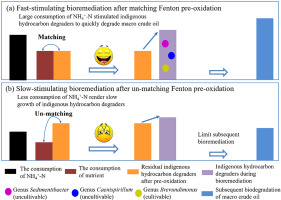当前位置:
X-MOL 学术
›
Chemosphere
›
论文详情
Our official English website, www.x-mol.net, welcomes your feedback! (Note: you will need to create a separate account there.)
Fast-stimulating bioremediation of macro crude oil in soils using matching Fenton pre-oxidation.
Chemosphere ( IF 8.8 ) Pub Date : 2020-04-01 , DOI: 10.1016/j.chemosphere.2020.126622 Jinlan Xu 1 , Juan Du 1 , Lu Li 1 , Qiuju Zhang 1 , Ziwei Chen 1
Chemosphere ( IF 8.8 ) Pub Date : 2020-04-01 , DOI: 10.1016/j.chemosphere.2020.126622 Jinlan Xu 1 , Juan Du 1 , Lu Li 1 , Qiuju Zhang 1 , Ziwei Chen 1
Affiliation

|
This study aims at exploring the mechanism of fast-stimulating bioremediation of macro crude oil using matching Fenton pre-oxidation. The 80-day biodegradation experiment for soil S1 and S2, containing macro crude oil: C19-C29 and C17-C29 respectively, was conducted after Fenton pre-oxidation with three concentrations of H2O2 (225 mM, 450 mM, and 900 mM). Experimental results indicated that the bioremediation efficiency of macro crude oil was up to 57.1% (8853 mg/kg, S1) and 64.4% (11,719 mg/kg, S2) for 80-day fast-stimulating bioremediation using matching Fenton pre-oxidation (450 mM H2O2), which was 1.8-2.6 times that (S1: 22.2-37.1%; S2: 36.1-39.6%) for slow-stimulating bioremediation using un-matching Fenton pre-oxidation. Furthermore, the high-throughput analysis revealed that genera Sedimentibacter, Caenispirillum, and Brevundimonas became the dominant bacteria after matching Fenton pre-oxidation. Meanwhile, the highest logarithmic growth rate of indigenous hydrocarbon degraders (IHD) was obtained (S1: 64% and S2: 60%) for fast-stimulating bioremediation. And the consumption of NH4+-N was up to 90% and 94% in S1 and S2 within 60 days for fast-stimulating bioremediation, approximately 1.4 and 2.2 times that (S1: 65% and 62%; S2: 47% and 41%) for slow-stimulating remediation. The results showed that the macro crude oil became the main carbon source for IHD for the fast-stimulating bioremediation, resulting in the rapid growth of IHD. Thus, this study provides a fast and efficient remediation technology for bioremediation of macro crude oil-contaminated soils.
中文翻译:

使用匹配的Fenton预氧化快速刺激土壤中大型原油的生物修复。
这项研究旨在探索使用匹配的Fenton预氧化快速刺激宏观原油生物修复的机理。在Fenton用三种浓度的H2O2(225 mM,450 mM和900 mM)进行预氧化后,对土壤S1和S2分别进行了80天的生物降解实验,分别含有大量原油:C19-C29和C17-C29。实验结果表明,使用匹配的Fenton预氧化法(80天快速刺激生物修复),大原油的生物修复效率分别高达57.1%(8853 mg / kg,S1)和64.4%(11,719 mg / kg,S2)。 450 mM H2O2)(S1:22.2-37.1%; S2:36.1-39.6%)的1.8-2.6倍(使用不匹配的Fenton预氧化进行缓慢刺激的生物修复)。此外,高通量分析显示,Sedimentibacter属,Caenispirillum属,Fenton预氧化匹配后,Brevundimonas成为优势细菌。同时,对于快速刺激的生物修复,获得了本地烃降解物(IHD)的最高对数增长率(S1:64%和S2:60%)。快速刺激生物修复的60天内,S1和S2中NH4 + -N的消耗量分别高达90%和94%,约为其1.4和2.2倍(S1:65%和62%; S2:47%和41% )进行缓慢刺激的修复。结果表明,宏观原油成为快速刺激生物修复中IHD的主要碳源,导致IHD快速增长。因此,本研究提供了一种对大型原油污染土壤进行生物修复的快速有效的修复技术。对于快速刺激的生物修复,获得了本地烃降解物(IHD)的最高对数增长率(S1:64%和S2:60%)。快速刺激生物修复的60天内,S1和S2中NH4 + -N的消耗量分别高达90%和94%,约为其1.4和2.2倍(S1:65%和62%; S2:47%和41% )进行缓慢刺激的修复。结果表明,宏观原油成为快速刺激生物修复中IHD的主要碳源,导致IHD快速增长。因此,本研究提供了一种对大型原油污染土壤进行生物修复的快速有效的修复技术。对于快速刺激的生物修复,获得了本地烃降解物(IHD)的最高对数增长率(S1:64%和S2:60%)。快速刺激生物修复的60天内,S1和S2中NH4 + -N的消耗量分别高达90%和94%,约为其1.4和2.2倍(S1:65%和62%; S2:47%和41% )进行缓慢刺激的修复。结果表明,宏观原油成为快速刺激生物修复中IHD的主要碳源,导致IHD快速增长。因此,本研究提供了一种对大型原油污染土壤进行生物修复的快速有效的修复技术。快速刺激生物修复的60天内,S1和S2中NH4 + -N的消耗量分别高达90%和94%,约为其1.4和2.2倍(S1:65%和62%; S2:47%和41% )进行缓慢刺激的修复。结果表明,宏观原油成为快速刺激生物修复中IHD的主要碳源,导致IHD快速增长。因此,本研究提供了一种对大型原油污染土壤进行生物修复的快速有效的修复技术。快速刺激生物修复的60天内,S1和S2中NH4 + -N的消耗量分别高达90%和94%,约为其1.4和2.2倍(S1:65%和62%; S2:47%和41% )进行缓慢刺激的修复。结果表明,宏观原油成为快速刺激生物修复中IHD的主要碳源,导致IHD快速增长。因此,本研究提供了一种对大型原油污染土壤进行生物修复的快速有效的修复技术。
更新日期:2020-04-01
中文翻译:

使用匹配的Fenton预氧化快速刺激土壤中大型原油的生物修复。
这项研究旨在探索使用匹配的Fenton预氧化快速刺激宏观原油生物修复的机理。在Fenton用三种浓度的H2O2(225 mM,450 mM和900 mM)进行预氧化后,对土壤S1和S2分别进行了80天的生物降解实验,分别含有大量原油:C19-C29和C17-C29。实验结果表明,使用匹配的Fenton预氧化法(80天快速刺激生物修复),大原油的生物修复效率分别高达57.1%(8853 mg / kg,S1)和64.4%(11,719 mg / kg,S2)。 450 mM H2O2)(S1:22.2-37.1%; S2:36.1-39.6%)的1.8-2.6倍(使用不匹配的Fenton预氧化进行缓慢刺激的生物修复)。此外,高通量分析显示,Sedimentibacter属,Caenispirillum属,Fenton预氧化匹配后,Brevundimonas成为优势细菌。同时,对于快速刺激的生物修复,获得了本地烃降解物(IHD)的最高对数增长率(S1:64%和S2:60%)。快速刺激生物修复的60天内,S1和S2中NH4 + -N的消耗量分别高达90%和94%,约为其1.4和2.2倍(S1:65%和62%; S2:47%和41% )进行缓慢刺激的修复。结果表明,宏观原油成为快速刺激生物修复中IHD的主要碳源,导致IHD快速增长。因此,本研究提供了一种对大型原油污染土壤进行生物修复的快速有效的修复技术。对于快速刺激的生物修复,获得了本地烃降解物(IHD)的最高对数增长率(S1:64%和S2:60%)。快速刺激生物修复的60天内,S1和S2中NH4 + -N的消耗量分别高达90%和94%,约为其1.4和2.2倍(S1:65%和62%; S2:47%和41% )进行缓慢刺激的修复。结果表明,宏观原油成为快速刺激生物修复中IHD的主要碳源,导致IHD快速增长。因此,本研究提供了一种对大型原油污染土壤进行生物修复的快速有效的修复技术。对于快速刺激的生物修复,获得了本地烃降解物(IHD)的最高对数增长率(S1:64%和S2:60%)。快速刺激生物修复的60天内,S1和S2中NH4 + -N的消耗量分别高达90%和94%,约为其1.4和2.2倍(S1:65%和62%; S2:47%和41% )进行缓慢刺激的修复。结果表明,宏观原油成为快速刺激生物修复中IHD的主要碳源,导致IHD快速增长。因此,本研究提供了一种对大型原油污染土壤进行生物修复的快速有效的修复技术。快速刺激生物修复的60天内,S1和S2中NH4 + -N的消耗量分别高达90%和94%,约为其1.4和2.2倍(S1:65%和62%; S2:47%和41% )进行缓慢刺激的修复。结果表明,宏观原油成为快速刺激生物修复中IHD的主要碳源,导致IHD快速增长。因此,本研究提供了一种对大型原油污染土壤进行生物修复的快速有效的修复技术。快速刺激生物修复的60天内,S1和S2中NH4 + -N的消耗量分别高达90%和94%,约为其1.4和2.2倍(S1:65%和62%; S2:47%和41% )进行缓慢刺激的修复。结果表明,宏观原油成为快速刺激生物修复中IHD的主要碳源,导致IHD快速增长。因此,本研究提供了一种对大型原油污染土壤进行生物修复的快速有效的修复技术。


























 京公网安备 11010802027423号
京公网安备 11010802027423号